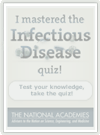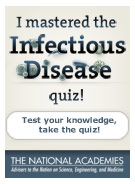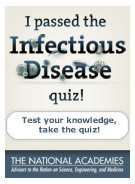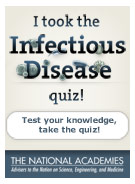
What You Need To Know About Infectious Disease
What do you know about infectious disease?
True or False: Scientists predict that rising average temperatures in some regions will change the transmission dynamics and geographic range of cholera, malaria, dengue fever, and tick-borne diseases.
-
Correct!
Scientists predict that rising average temperatures in some regions—a result of climate change—will change the transmission dynamics and geographic range of cholera, malaria, dengue fever, and tick-borne diseases.
-
Sorry, that’s incorrect.
Scientists predict that rising average temperatures in some regions—a result of climate change—will change the transmission dynamics and geographic range of cholera, malaria, dengue fever, and tick-borne diseases.
True or False: Our bodies contain at least 10 times more human cells than bacterial cells.
-
Sorry, that’s incorrect.
Our bodies contain at least 10 times more bacterial cells than human cells.
-
Correct!
Our bodies contain at least 10 times more bacterial cells than human cells.
Which are examples of ways that pathogens (disease-causing microbes) can spread?
- Coughing
- Eating undercooked pork
- Flea bite
- Breathing dust particles containing microorganisms
- All of the above
-
Sorry, that’s incorrect.
All are examples of ways that pathogens can spread. Coughing is an example of airborne droplet transmission; eating undercooked pork is an example of common vehicle transmission; a flea bite is an example of vector transmission; and breathing contaminated dust particles is an example of airborne transmission.
-
Sorry, that’s incorrect.
All are examples of ways that pathogens can spread. Coughing is an example of airborne droplet transmission; eating undercooked pork is an example of common vehicle transmission; a flea bite is an example of vector transmission; and breathing contaminated dust particles is an example of airborne transmission.
-
Sorry, that’s incorrect.
All are examples of ways that pathogens can spread. Coughing is an example of airborne droplet transmission; eating undercooked pork is an example of common vehicle transmission; a flea bite is an example of vector transmission; and breathing contaminated dust particles is an example of airborne transmission.
-
Sorry, that’s incorrect.
All are examples of ways that pathogens can spread. Coughing is an example of airborne droplet transmission; eating undercooked pork is an example of common vehicle transmission; a flea bite is an example of vector transmission; and breathing contaminated dust particles is an example of airborne transmission.
-
Correct!
All are examples of ways that pathogens can spread. Coughing is an example of airborne droplet transmission; eating undercooked pork is an example of common vehicle transmission; a flea bite is an example of vector transmission; and breathing contaminated dust particles is an example of airborne transmission.
Where do microbes live?
-
Sorry, that’s incorrect.
Microbes live in all of these places. They also live in plants and in the air. They can even survive in extreme environments like hot springs, deep ocean thermal vents, and polar ice.
-
Sorry, that’s incorrect.
Microbes live in all of these places. They also live in plants and in the air. They can even survive in extreme environments like hot springs, deep ocean thermal vents, and polar ice.
-
Sorry, that’s incorrect.
Microbes live in all of these places. They also live in plants and in the air. They can even survive in extreme environments like hot springs, deep ocean thermal vents, and polar ice.
-
Sorry, that’s incorrect.
Microbes live in all of these places. They also live in plants and in the air. They can even survive in extreme environments like hot springs, deep ocean thermal vents, and polar ice.
-
Correct!
Microbes live in all of these places. They also live in plants and in the air. They can even survive in extreme environments like hot springs, deep ocean thermal vents, and polar ice.
Which of the following is NOT a vector-borne disease?
-
Correct!
Influenza is not a vector-borne disease, meaning it is not transmitted to humans indirectly via an insect, an arthropod, or another animal. Malaria and yellow fever are transmitted by mosquitoes. Lyme disease is transmitted by deer ticks.
-
Sorry, that’s incorrect.
Influenza is not a vector-borne disease, meaning it is not transmitted to humans indirectly via an insect, an arthropod, or another animal. Malaria and yellow fever are transmitted by mosquitoes. Lyme disease is transmitted by deer ticks.
-
Sorry, that’s incorrect.
Influenza is not a vector-borne disease, meaning it is not transmitted to humans indirectly via an insect, an arthropod, or another animal. Malaria and yellow fever are transmitted by mosquitoes. Lyme disease is transmitted by deer ticks.
-
Sorry, that’s incorrect.
Influenza is not a vector-borne disease, meaning it is not transmitted to humans indirectly via an insect, an arthropod, or another animal. Malaria and yellow fever are transmitted by mosquitoes. Lyme disease is transmitted by deer ticks.
What fraction of all deaths worldwide are caused by infectious disease?
-
Sorry, that’s incorrect.
About one quarter of all deaths worldwide are caused by infectious disease. More than two-thirds of the deaths in children under the age of five are caused by infectious disease.
-
Correct!
About one quarter of all deaths worldwide are caused by infectious disease. More than two-thirds of the deaths in children under the age of five are caused by infectious disease.
-
Sorry, that’s incorrect.
About one quarter of all deaths worldwide are caused by infectious disease. More than two-thirds of the deaths in children under the age of five are caused by infectious disease.
Which is the vector (animal that carries the pathogen) for West Nile virus?
-
Sorry, that’s incorrect.
The mosquito is the vector for West Nile virus. The mosquito suffers no ill effects from the virus but transmits it to humans and other warm-blooded creatures (such as crows) when it takes a blood meal.
-
Correct!
The mosquito is the vector for West Nile virus. The mosquito suffers no ill effects from the virus but transmits it to humans and other warm-blooded creatures (such as crows) when it takes a blood meal.
-
Sorry, that’s incorrect.
The mosquito is the vector for West Nile virus. The mosquito suffers no ill effects from the virus but transmits it to humans and other warm-blooded creatures (such as crows) when it takes a blood meal.
-
Sorry, that’s incorrect.
The mosquito is the vector for West Nile virus. The mosquito suffers no ill effects from the virus but transmits it to humans and other warm-blooded creatures (such as crows) when it takes a blood meal.
How long did it take the 2009 “swine flu” pandemic to spread to 30 countries?
-
Sorry, that’s incorrect.
The 2009 “swine flu” pandemic starkly illustrated the impact of globalization and air travel on the movement of infectious diseases—with the infection spreading to 30 countries within six weeks and to more than 190 countries and territories within months.
-
Correct!
The 2009 “swine flu” pandemic starkly illustrated the impact of globalization and air travel on the movement of infectious diseases—with the infection spreading to 30 countries within six weeks and to more than 190 countries and territories within months.
-
Sorry, that’s incorrect.
The 2009 “swine flu” pandemic starkly illustrated the impact of globalization and air travel on the movement of infectious diseases—with the infection spreading to 30 countries within six weeks and to more than 190 countries and territories within months.
In 2008, about how many people worldwide were infected with HIV (human immunodeficiency virus)?
-
Sorry, that’s incorrect.
In 2008, more than 33 million people worldwide were infected with HIV (human immunodeficiency virus). In that same year, an estimated 2 million people died from AIDS (acquired immunodeficiency syndrome), the final stage of HIV infection.
-
Sorry, that’s incorrect.
In 2008, more than 33 million people worldwide were infected with HIV (human immunodeficiency virus). In that same year, an estimated 2 million people died from AIDS (acquired immunodeficiency syndrome), the final stage of HIV infection.
-
Correct!
In 2008, more than 33 million people worldwide were infected with HIV (human immunodeficiency virus). In that same year, an estimated 2 million people died from AIDS (acquired immunodeficiency syndrome), the final stage of HIV infection.
Thank you for taking our quiz.
Place this badge on your Facebook page to show your friends what you know about infectious disease.
Place this badge on your Facebook page to show your friends what you know about infectious disease.
OR, get a higher score to unlock a different badge.

Place this badge on your Facebook page to show your friends what you know about infectious disease.
OR, get a higher score to unlock a different badge.

Explore Other Topics
Disease Watchlist
Infectious Disease Defined
- Parasitism
A close relationship between two organisms in which one organism, the parasite, benefits at the expense of the host organism.


